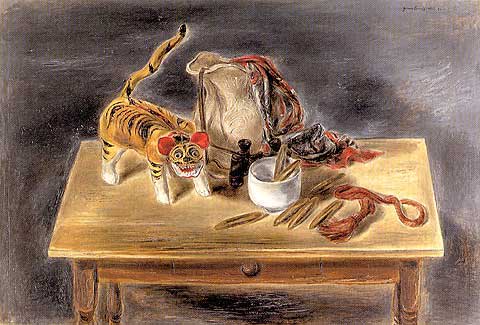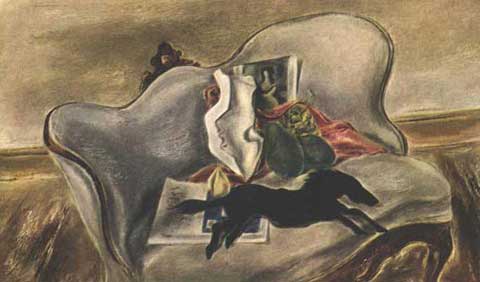クニヨシの静物画は、物体の物理的存在、その様々な形態、色彩と肌合い、そして
それらを取り巻く環境とそれぞれの相関関係を楽しませる表現でした。
物体自身は、さほど重要ではなく、それを使って何が出来るかが画家としての彼に興味を
持たせたのです。
彼は、不調和に思われる物を組み合わせました、花瓶、一握りの葉巻、スカーフ、双眼鏡、
タイタンの写真、を明らかに解る無秩序の中でそれらを一緒にくっつけています。
日常生活の中で物との間の正常な関係が無視されているか、逆になっています; たびたび
物体はお互いの上に積み重ねられ、バランスが取れ、すばらしい構造物を造り上げています。
彼の初期の作品に出てきた動物たちに取って代わる物として、日本のオモチャのトラや馬の形
をした風向計のように、よくそこには動物のイメージがありました、しかし今は実際の動物に
変わってシンボルとしてあります。
これらの静物画は常に単に無機的物質の組み立て以上に思われます、彼らは象徴的意味の
要素を含んでいて、その物体以上の何かを暗示しています。 彼の静物画の話でクニヨシは
どんな題材を描いても、それに幅広い影響を持たせることが出来ると述べています。

"Japanese Toy Tiger and Odd Objects" 1932. Oil on Canvas. (34 1/2 x 49 1/2 in)
Collection Dr. Harry A. Blutman.
Kuniyoshi's still-lifes were the expression of delight in the physical properties
of objects, their varying forms, colors and textures, and their relations to one
another and to their surroundings. The objects themselves were of minor im-
portance; it was what he could make of them that interested the artist. He as-
sembled seemingly incongruous things - a vase, a handful of cigars, a scarf, a
pair of binoculars, a photograph of a Titian - putting them together in apparent
disorder. The normal relations between things in everyday life were disregarded,
or reversed; frequently objects were piled one on top of another, balance, build-
ing up a fantastic structure. Often there was an image of an animal, such as a
Japanese toy tiger or weathervane in the shape of a horse - successors of the
animals that had appeared in his early pictures, but now symbols instead of the
actual creatures. These still-lifes always seemed more than an assemblage of in-
animate objects; they contained an element of symbolism, a suggestion of some-
thing beyond the things themselves. Speaking of his still-lifes Kuniyoshi observes
that one can paint any subject and give it wide implications.

"Weather Vane and Sofa" 1933. Oil on Canvas. (36 x 60 in)
Santa Barbara Museum of Art.
訳註:フロク・3 学友で、リーグでのスクール・メートでなく取り上げられなかったウォルト・
カーンとポップ・ハートの二人をロイドが紹介したペンギン・クラブのページに追加しました。
シリアス・パスキンは、 ”読書 その三十一 二度目のパリ”をご覧下さい。
それらを取り巻く環境とそれぞれの相関関係を楽しませる表現でした。
物体自身は、さほど重要ではなく、それを使って何が出来るかが画家としての彼に興味を
持たせたのです。
彼は、不調和に思われる物を組み合わせました、花瓶、一握りの葉巻、スカーフ、双眼鏡、
タイタンの写真、を明らかに解る無秩序の中でそれらを一緒にくっつけています。
日常生活の中で物との間の正常な関係が無視されているか、逆になっています; たびたび
物体はお互いの上に積み重ねられ、バランスが取れ、すばらしい構造物を造り上げています。
彼の初期の作品に出てきた動物たちに取って代わる物として、日本のオモチャのトラや馬の形
をした風向計のように、よくそこには動物のイメージがありました、しかし今は実際の動物に
変わってシンボルとしてあります。
これらの静物画は常に単に無機的物質の組み立て以上に思われます、彼らは象徴的意味の
要素を含んでいて、その物体以上の何かを暗示しています。 彼の静物画の話でクニヨシは
どんな題材を描いても、それに幅広い影響を持たせることが出来ると述べています。

"Japanese Toy Tiger and Odd Objects" 1932. Oil on Canvas. (34 1/2 x 49 1/2 in)
Collection Dr. Harry A. Blutman.
Kuniyoshi's still-lifes were the expression of delight in the physical properties
of objects, their varying forms, colors and textures, and their relations to one
another and to their surroundings. The objects themselves were of minor im-
portance; it was what he could make of them that interested the artist. He as-
sembled seemingly incongruous things - a vase, a handful of cigars, a scarf, a
pair of binoculars, a photograph of a Titian - putting them together in apparent
disorder. The normal relations between things in everyday life were disregarded,
or reversed; frequently objects were piled one on top of another, balance, build-
ing up a fantastic structure. Often there was an image of an animal, such as a
Japanese toy tiger or weathervane in the shape of a horse - successors of the
animals that had appeared in his early pictures, but now symbols instead of the
actual creatures. These still-lifes always seemed more than an assemblage of in-
animate objects; they contained an element of symbolism, a suggestion of some-
thing beyond the things themselves. Speaking of his still-lifes Kuniyoshi observes
that one can paint any subject and give it wide implications.

"Weather Vane and Sofa" 1933. Oil on Canvas. (36 x 60 in)
Santa Barbara Museum of Art.
訳註:フロク・3 学友で、リーグでのスクール・メートでなく取り上げられなかったウォルト・
カーンとポップ・ハートの二人をロイドが紹介したペンギン・クラブのページに追加しました。
シリアス・パスキンは、 ”読書 その三十一 二度目のパリ”をご覧下さい。




























goo メールは、こちら:
pacleaf@mail.goo.ne.jp
画像を送って下さい。
朝はオート・ミールでしょうか、それともベーコン、目玉焼きにトーストでしょうか?
コーヒーにドーナッツの日があったかも?